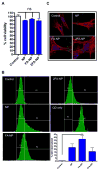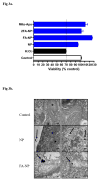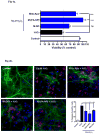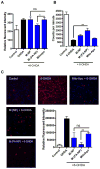Neuronal protection against oxidative insult by polyanhydride nanoparticle-based mitochondria-targeted antioxidant therapy
- PMID: 27771430
- PMCID: PMC5392427
- DOI: 10.1016/j.nano.2016.10.004
Neuronal protection against oxidative insult by polyanhydride nanoparticle-based mitochondria-targeted antioxidant therapy
Abstract
A progressive loss of neuronal structure and function is a signature of many neurodegenerative conditions including chronic traumatic encephalopathy, Parkinson's, Huntington's and Alzheimer's diseases. Mitochondrial dysfunction and oxidative and nitrative stress have been implicated as key pathological mechanisms underlying the neurodegenerative processes. However, current therapeutic approaches targeting oxidative damage are ineffective in preventing the progression of neurodegeneration. Mitochondria-targeted antioxidants were recently shown to alleviate oxidative damage. In this work, we investigated the delivery of biodegradable polyanhydride nanoparticles containing the mitochondria-targeted antioxidant apocynin to neuronal cells and the ability of the nano-formulation to protect cells against oxidative stress. The nano-formulated mitochondria-targeted apocynin provided excellent protection against oxidative stress-induced mitochondrial dysfunction and neuronal damage in a dopaminergic neuronal cell line, mouse primary cortical neurons, and a human mesencephalic cell line. Collectively, our results demonstrate that nano-formulated mitochondria-targeted apocynin may offer improved efficacy of mitochondria-targeted antioxidants to treat neurodegenerative disease.
Keywords: Mito-apocynin; Neurodegeneration; Oxidative stress; Polyanhydride nanoparticles.
Copyright © 2016 Elsevier Inc. All rights reserved.
Conflict of interest statement
The authors declare no competing financial interests.
Figures





Similar articles
-
Mito-Apocynin Prevents Mitochondrial Dysfunction, Microglial Activation, Oxidative Damage, and Progressive Neurodegeneration in MitoPark Transgenic Mice.Antioxid Redox Signal. 2017 Nov 10;27(14):1048-1066. doi: 10.1089/ars.2016.6905. Epub 2017 Apr 4. Antioxid Redox Signal. 2017. PMID: 28375739 Free PMC article.
-
Mitoapocynin Treatment Protects Against Neuroinflammation and Dopaminergic Neurodegeneration in a Preclinical Animal Model of Parkinson's Disease.J Neuroimmune Pharmacol. 2016 Jun;11(2):259-78. doi: 10.1007/s11481-016-9650-4. Epub 2016 Feb 2. J Neuroimmune Pharmacol. 2016. PMID: 26838361 Free PMC article.
-
Biodegradable polyanhydride-based nanomedicines for blood to brain drug delivery.J Biomed Mater Res A. 2018 Nov;106(11):2881-2890. doi: 10.1002/jbm.a.36477. Epub 2018 Oct 26. J Biomed Mater Res A. 2018. PMID: 30369055 Free PMC article.
-
Nano-antioxidants: An emerging strategy for intervention against neurodegenerative conditions.Neurochem Int. 2015 Oct;89:209-26. doi: 10.1016/j.neuint.2015.08.011. Epub 2015 Aug 24. Neurochem Int. 2015. PMID: 26315960 Review.
-
Mitochondria-targeted peptide antioxidants: novel neuroprotective agents.AAPS J. 2006 Aug 18;8(3):E521-31. doi: 10.1208/aapsj080362. AAPS J. 2006. PMID: 17025271 Free PMC article. Review.
Cited by
-
Nanoparticle-Facilitated Therapy: Advancing Tools in Peripheral Nerve Regeneration.Int J Nanomedicine. 2024 Jan 3;19:19-34. doi: 10.2147/IJN.S442775. eCollection 2024. Int J Nanomedicine. 2024. PMID: 38187908 Free PMC article. Review.
-
Mitochondria as Potential Targets in Alzheimer Disease Therapy: An Update.Front Pharmacol. 2019 Aug 23;10:902. doi: 10.3389/fphar.2019.00902. eCollection 2019. Front Pharmacol. 2019. PMID: 31507410 Free PMC article. Review.
-
Innovative Therapies and Nanomedicine Applications for the Treatment of Alzheimer's Disease: A State-of-the-Art (2017-2020).Int J Nanomedicine. 2020 Aug 14;15:6113-6135. doi: 10.2147/IJN.S231480. eCollection 2020. Int J Nanomedicine. 2020. PMID: 32884267 Free PMC article. Review.
-
Application of Nanomaterials in the Production of Biomolecules in Microalgae: A Review.Mar Drugs. 2023 Nov 16;21(11):594. doi: 10.3390/md21110594. Mar Drugs. 2023. PMID: 37999418 Free PMC article. Review.
-
Targeting with nanoparticles for the therapeutic treatment of brain diseases.J Tissue Eng. 2020 Mar 4;11:2041731419897460. doi: 10.1177/2041731419897460. eCollection 2020 Jan-Dec. J Tissue Eng. 2020. PMID: 32180936 Free PMC article. Review.
References
-
- Tofaris GK, Schapira AH. Neurodegenerative diseases in the era of targeted therapeutics: how to handle a tangled issue. Molecular and cellular neurosciences. 2015 - PubMed
Publication types
MeSH terms
Substances
Grants and funding
LinkOut - more resources
Full Text Sources
Other Literature Sources
Medical

